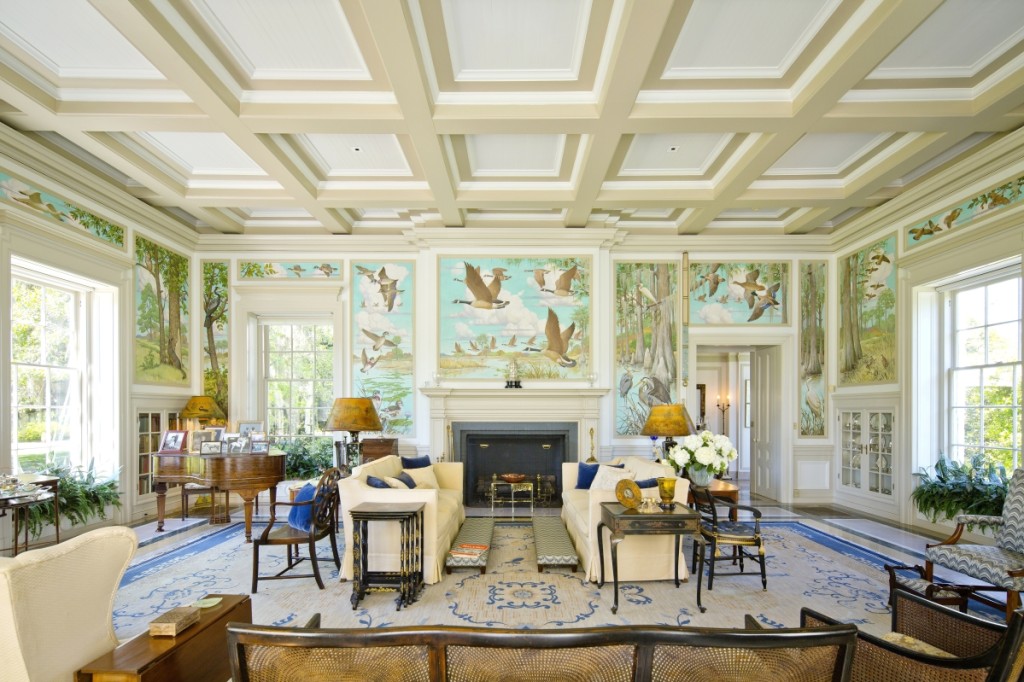
The main drawing room is decorated with murals on canvas painted by noted illustrator J. Clinton Shepherd (1888–1975) in his Palm Beach studio and later applied to the walls. The scenes depict the flora and fauna of southern Georgia as they appeared in the late 1940s.
By Karla Klein Albertson
THOMASVILLE, GA. – As the Gilded Age was born in the final decades of the Nineteenth Century, wealthy families from the Northeast and Midwest sought pleasant places to enjoy leisure time. Southern Georgia was warm in the winter months, and large tracts of land could be purchased for bargain prices. The town of Thomasville at the end of the railway line and the surrounding countryside grew into a popular destination for social and sporting holidays far away from the northern snows. Today it is also known in the trade for the Thomasville Antiques Show. Now in its 29th year, the event planned for February 22-25 attracts exhibitors from New York, New England and California, as well as from the South.
Among the prosperous Northerners who put down roots in the area, Cleveland industrialist Howard Melville Hanna (1841-1930) purchased multiple estates, among them, in 1896, Pebble Hill Plantation. As the property descended in the family, women in the lineage built grand structures, enjoyed outdoor activities in the field and gathered a comprehensive collection of sporting art and antiques.
Today, Pebble Hill Plantation is open to the public and currently is presenting its first major loan exhibition of fine art in its second-floor galleries. “Wild in the Country” features wildlife art by four major artists. On view through April 29, the paintings come from the collection of the Genesee Country Village and Museum in Mumford, N.Y. For those only familiar with the antebellum crop-growing plantations of the Gone with the Wind variety, the saga of Pebble Hill presents an alternative history of land use in the South.
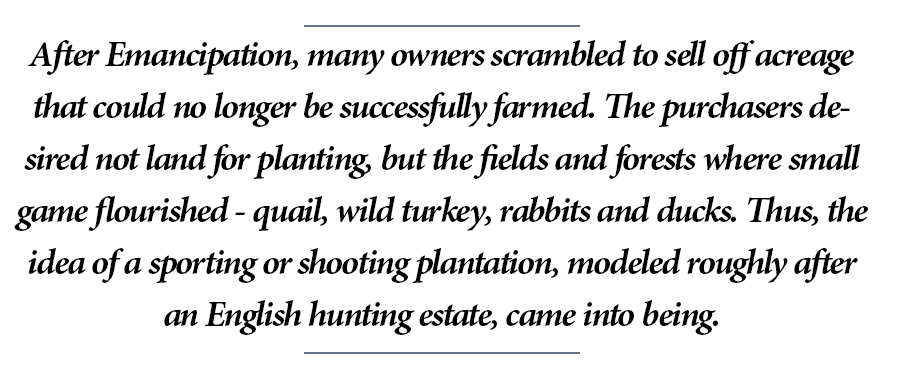 By 1900, Thomasville had become a vacation destination, its success enabled by rapid transit on the rails. When Northern cities shivered under a blanket of factory smoke during the long winters, southern Georgia had air that was not only pleasantly warm, but was praised for its health-promoting properties, curative for diseases like tuberculosis. Exotic flora bloomed, Spanish moss draped the live oak trees, and fauna filled the pine forests, where the creatures could be watched, painted or pursued.
By 1900, Thomasville had become a vacation destination, its success enabled by rapid transit on the rails. When Northern cities shivered under a blanket of factory smoke during the long winters, southern Georgia had air that was not only pleasantly warm, but was praised for its health-promoting properties, curative for diseases like tuberculosis. Exotic flora bloomed, Spanish moss draped the live oak trees, and fauna filled the pine forests, where the creatures could be watched, painted or pursued.
Archival photos of the town at the turn of the century show visitors enjoying themselves amid the amenities of massive, multilevel resort properties, such as the Piney Woods Hotel, which offered open verandas, elegant suppers and fancy-dress balls in season. Bicycling, golf, tennis, riding and hunting had enthusiasts among the prosperous hotel guests. The regional attractions were so seductive that the wealthiest families began to buy up local estates where they could establish a permanent seasonal home base.
Prior to the Civil War, Georgia had indeed been home to productive sugar cane, cotton and rice plantations, made profitable by the use of enslaved laborers. After Emancipation, many owners scrambled to sell off acreage that could no longer be successfully farmed. The purchasers desired not land for planting, but the fields and forests where small game flourished – quail, wild turkey, rabbits and ducks. Thus, the idea of a sporting or shooting plantation, modeled roughly after an English hunting estate, came into being. Stables were built to house fine horses, and men and women engaged in equestrian pursuits or toured the lush countryside in carriages.
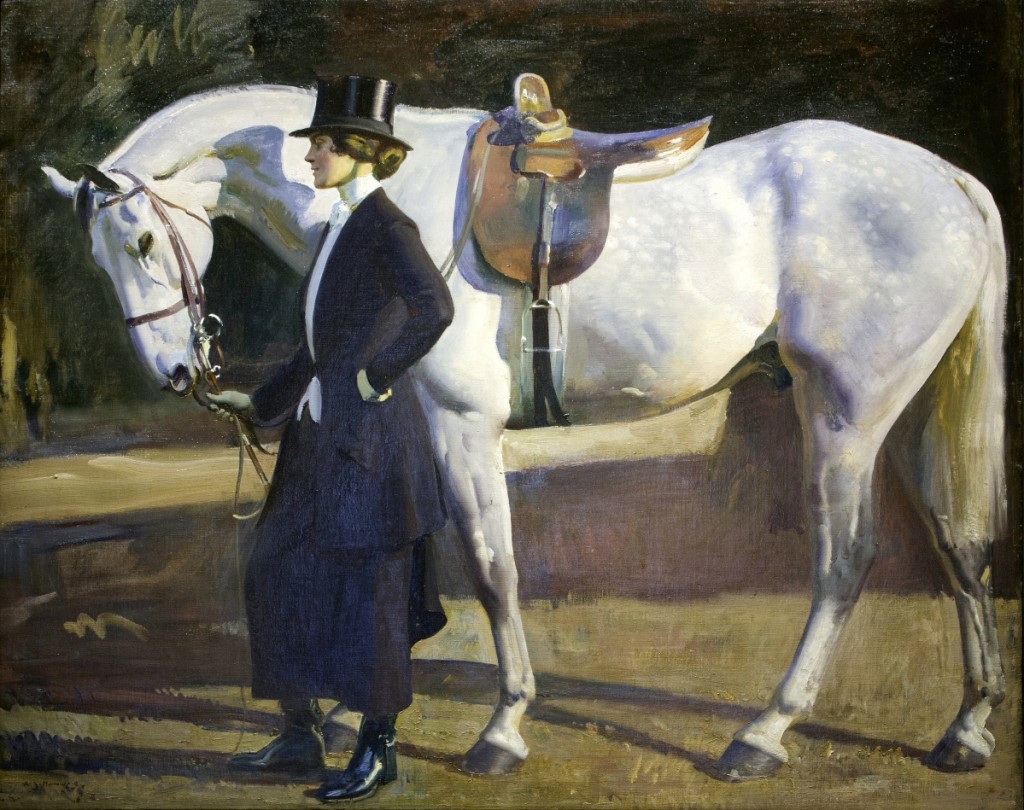
Sir Alfred Munnings (1878–1959) was one of England’s finest painters of horses. A treasure in the Pebble Hill Plantation collection, “The Artist’s Wife and ‘Isaac’” depicts Violet McBride, whom Munnings married in 1920, with her favorite mount.
Clevelander Mel Hanna fell in love with the region after an initial visit and purchased great swaths of land around Thomasville, including the Pebble Hill, Melrose and Winnstead Plantations. When acquired in 1896, Pebble Hill still retained a mid-Nineteenth Century great house designed by English architect John Wind (1819-1863), who had been especially active in southwest Georgia. At the time of its purchase, the structure appears sadly dilapidated in archival photographs. But when Hanna gave the plantation to his daughter Kate Hanna Ireland Harvey (1871-1936) in 1901, the property’s fortunes began a journey of construction and acquisition that produced the attractive complex of buildings visitors see today.
Kate not only renovated and updated the Wind House, as it was called, but she employed Abram Garfield (1872-1958), her favorite architect and President James Garfield’s youngest son, to design an addition completed in 1914. In addition to the 100-foot-long loggia, the supplement included a large sitting room and three bedrooms. This Loggia Wing, which can still be toured, survived a serious fire in 1934 that completely destroyed the original Wind House. Garfield returned to Pebble Hill. The mansion on view today, incorporating that 1914 wing, was completed in 1936, just before Kate passed away.
While her mother had been responsible for the completion of buildings and gardens in the estate complex, it was inheriting daughter Elisabeth “Pansy” Ireland (1897-1978), later married to Parker Poe, who formed the important collection of sporting art. Pansy was a superb horsewoman, whether galloping with the pack on hunts, whacking the ball across a polo field or raising thoroughbreds to show and race. When she was not enjoying the outdoor life, the heiress began to furnish the central mansion with collections of paintings, prints, sculpture and decorative arts dominated by sporting and wildlife themes. While the hall might be lined with stately Audubons, painted birds flew across the drawing room walls, accented fabric patterns and waddled across the dessert plates. Animals appear at every turn throughout the main house and public areas.
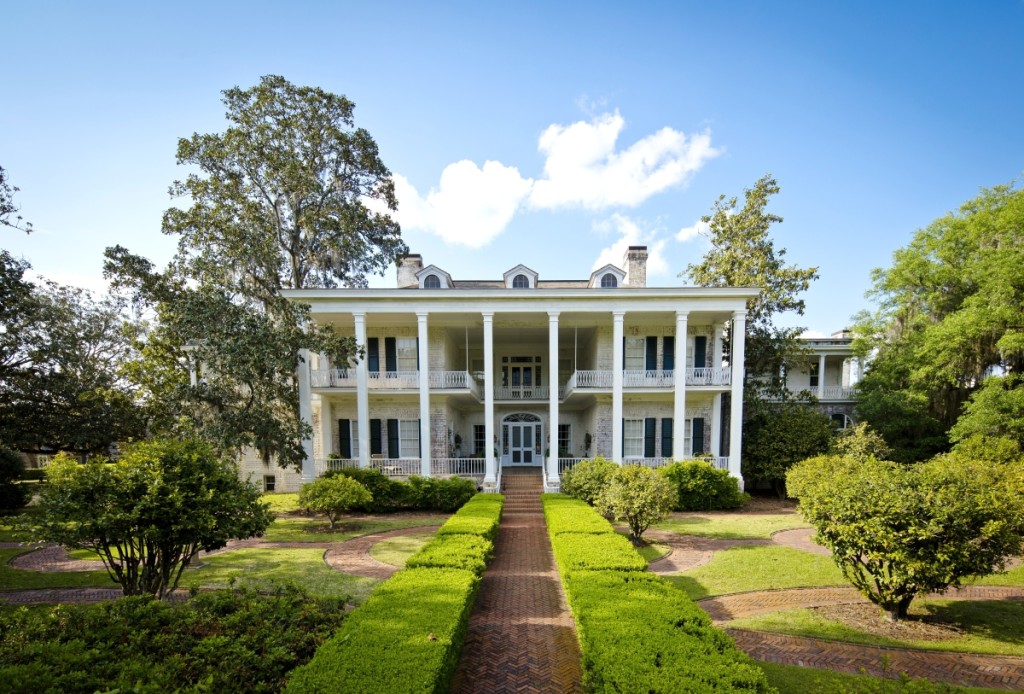
The main house at Pebble Hill Plantation, completed in 1936, was designed by architect Abram Garfield (1872–1958), youngest son of President James Garfield.
In Legacies from the Women, a book by Jean Hagen Johnson published by the Pebble Hill Foundation in 1999, the author discussed Pansy’s devotion to collecting: “Here, today… one may see vast services of exquisite china and silver, crystal goblets and wine glasses of all kinds, hunt cups, silver place-card holders wrought in the shape of various breeds of hunting dogs, paintings, figurines and statuary (often dogs and horses)…much of it displayed in softly lit cabinets and much also at hand in the pantry for daily use.”
Wildlife and sporting art specialist Brooke Chilvers, who writes for Gray’s Sporting Journal and her own www.brookessportingartgallery.com site, commented recently, “The sporting art collection at Pebble Hill Plantation allows visitors to experience such works in their original setting of a fine Southern shooting estate instead of the auction floor. Collected by Elisabeth Ireland Poe, owner of PHP from 1936 to 1978, it comprises not only the works of prominent English sporting artists John Emms, Maud Earl and Thomas Blinks, but also the various American artists who were regular guests at the plantation, including Aiden Lassell Ripley, Richard Bishop and Ogden Pleissner, the very symbols of the glory years of Southern country sport.”
Among the important art gathered by Mrs Poe, one of the most magnificent paintings is “The Artist’s Wife and ‘Isaac'” by Sir Alfred Munnings (1878-1959). He was one of England’s finest painters of horses, and the handsome mount depicted shares a canvas with the artist’s attractive wife, Violet McBride, whom Munnings married in 1920. Munnings’ works have often broken the million-dollar mark at auction. More of the painter’s extensive output can be seen at England’s Munnings Art Museum in Essex.
Pansy Ireland and Parker Poe had no children. Upon her death in 1978, the property was given to a private foundation, which opened the estate to the public in 1983. Pebble Hill Plantation today has a variety of attractions – visitors can tour the historic house filled with antiques as well as the second- floor galleries containing major works from the permanent art collection. Outside, the stunningly beautiful grounds, stables and estate structures can be rented for weddings, parties and outdoor activities, all described on the lively www.pebblehill.com website. The plantation lies close to the southern border of Georgia. Travelers often fly into the Tallahassee, Fla., airport, less than a half hour away.
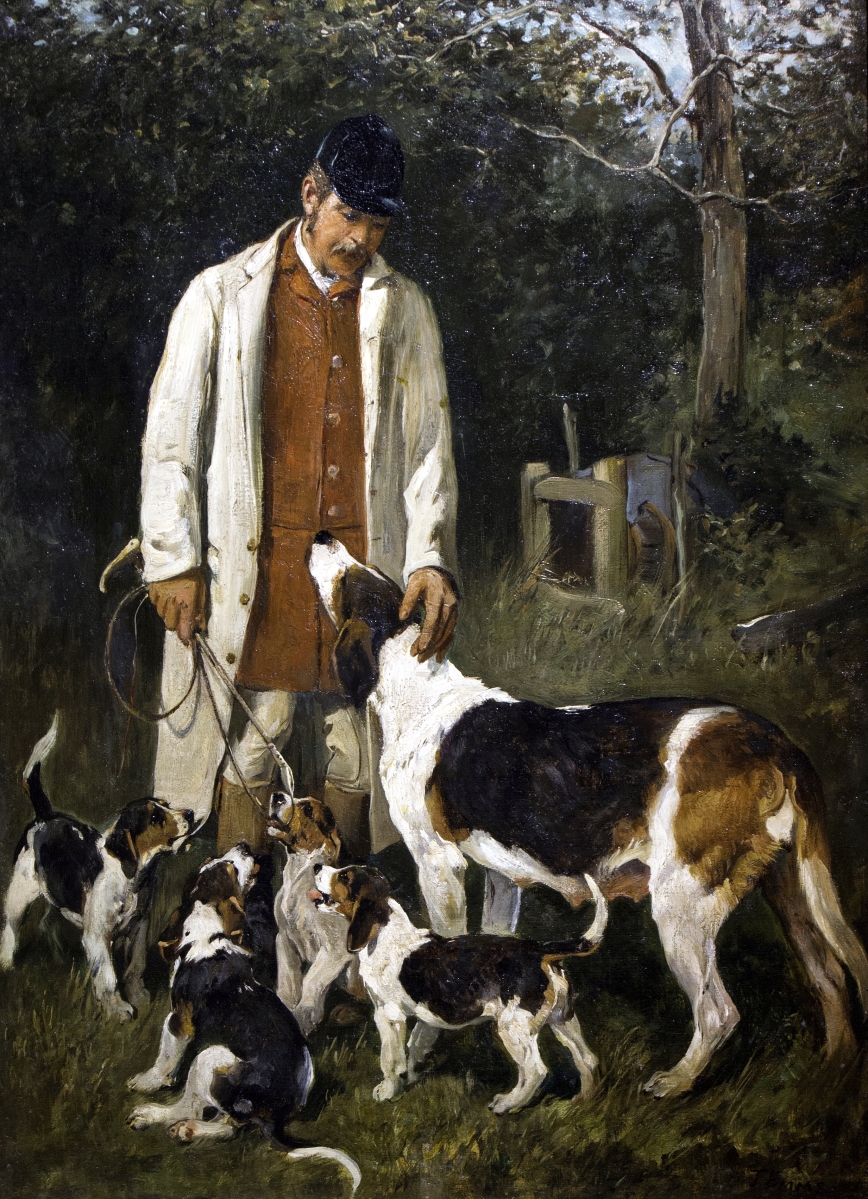
English painter John Emms (1843–1912) was the favorite artist of Pebble Hill’s owners. From the permanent collection, this view of a “Huntsman, Hound and Puppies” records a scene not unlike sporting activities that took place on the plantation.
Thomasville has always benefited from the trade brought by tourists as well as permanent and seasonal residents. The center of town has remained a charming destination, filled with boutiques, outfitters and farm-to-table fare. The decision to add loan exhibitions to Pebble Hill Plantation’s appeal will encourage repeat visits from short-term guests and land-owning residents. Executive Director Whitney White says, “‘Wild in the Country: Wildlife Art from the Genesee County Village and Museum’ is the first large show we’ve brought in. We had a wonderful experience working with that museum. The Pebble Hill board made the decision to turn the upstairs of the house into a true gallery space. Their vision was that we would be able to bring in shows like this one, so that we can reach audiences locally, regionally and nationally – to give them a reason to come here again and again.”
“Wild in the Country” includes the work of American illustrator and painter Robert Frederik Kuhn (1920-2007); German-born realist Friedrich Wilhelm Kuhnert (1865-1926), who traveled in Africa; Swedish painter of wildlife Bruno Liljefors (1864-1939); and German-born artist Carl Rungius (1869-1959), who moved to the United States to paint Western scenes.
Genesee President and Chief Executive Officer Becky Wehle describes the formation of her grandfather’s collection: “John L. Wehle – also known as Jack – inherited a love of the outdoors and animals from his father. He started collecting art in his 40s and did so up until the day he died. Virtually all of the artworks in our collection were purchased by my grandfather. The four artists who are featured in the exhibit are considered some of the best of all time. As for how we got connected to Pebble Hill, they have a similar background to us with the history of one family being involved, and we knew of their collection of sporting art by reputation.”
Pebble Hill’s winter “high season” corresponds with the Genesee Museum’s winter closure, so the timing is perfect for both institutions. The loan exhibition highlights animal interactions in environments far different from the warm forests and fields of southern Georgia and thus expands visitors’ understanding of wildlife in various natural habitats. The current show promises to be the first of many varied exhibitions on similar themes.
Pebble Hill Plantation is five miles south of Thomasville at 1251 US Highway 319 South. For further information, www.pebblehill.com or 229-226-2344.
Journalist Karla Klein Albertson writes about decorative arts and design.



















